
| Command Post | September 28, 2007 |
With the season winding down, and as a bit of foreshadowing for the playoff preview I'm writing next week, I wanted to use my PITCH f/x database to look at Jake Peavy from something like an advance scouting point of view. Peavy, the ace of the Padres staff, has had a great season, highlighted by an unbelievable month of May and currently leads the Majors in ERA and WHIP as well as the National League in strikeouts and wins. I've been dancing around advance scouting in some my articles, by diagraming how a pitch moves or examining what pitchers throw in high leverage situations, but I haven't put it all together in one place yet. While I've never seen an MLB advance scouting report, I think a good place to start is with an examination of what a pitcher throws, when he throws it, and what happens once he throws it. Using this framework, you can identify a pitcher's strengths, weaknesses and tendencies.
Pitch Profile-What does he throw?
Here's a chart of Peavy's pitches, showing the differences between his pitches and their non-spinning equivalents.

One thing that sticks out in this graph is the large group of sliders and when I looked at Peavy before I was unsure how to handle that group of pitches. If you look close enough, you begin to make out two groups, although overall they appear to be variations on his slider rather than two unique pitches.
Pitch N Speed Pfx Pfz BreakX BreakZ FB 751 94.2 -8.69 10.68 3.11 3.09 SL 473 86.3 2.39 4.52 -1.25 6.74 CH 79 85.7 -8.10 4.36 2.90 6.81 CB 30 73.8 6.42 -5.57 -2.65 13.80
Peavy's fastball is thrown hard and hitters will see it as having slightly less "drop", relative to an average RHP fastball. The smaller amount of drop gives the illusion of a rising fastball, which is reflected by a higher than average pfz value. His fastball also has more arm-side movement than an average RHP fastball does.
Almost every pitcher throws their fastball the most and will throw their "out" pitch, if they have one, the next most, usually far more than average for that pitch type. Peavy is no exception to this pattern, and 35% of his pitches are sliders, compared to the average for RHP, which is 19%. His slider breaks away from RHH and drops less than an average slider, although in both cases, not by very much. It is thrown at roughly the same speed as his changeup, although they move in opposite horizontal directions. The wide range of possible slider movements makes comparisons against an average slider a little less precise than for fastballs. Sliders are essentially what's left over after fastballs, curveballs and changeups have been identified, the scrapple of pitches, and there is more variation among sliders (and cutters) thrown by different pitchers than any other pitch.
Peavy's changeup has similar movement to his fastball, except it travels 10 MPH slower. He doesn't throw his changeup much (6% of pitches) and his curveball even less (2%).
Situational Pitching-When does he throw it?
If hitters are curious about which pitches to look for, here's a graph showing the frequency that Peavy throws each of his pitches, by inning.
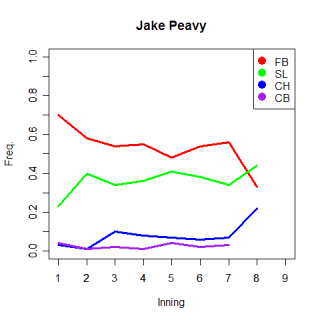
You can really see Peavy's reliance on his fastball and slider from this graph. 70% of Peavy's first inning pitches are fastballs (Avg. RHP throws 60%) and while there are any number of reasons why his first inning fastball percentage is higher than average (he doesn't want hitters to see his slider early in the game, he's trying to make sure he has command of his fastball, he's trying to establish his fasbtball as a pitch) it could just be because he really only throws two pitches. As the game moves along, he throws fewer fastballs and focuses more on his slider, which is consistent with how most pitchers operate. I only have data for 9 pitches of his in the 8th inning, so there probably isn't anything to the fact that only 3 of them are fastballs.
Now look closer at the staggered increases in his changeups and curveballs in the third and fifth innings respectively. These changes mirror the increase in sliders in the second inning. One possibility to explain these changes is that Peavy might not want to show his full arsenal of pitches to hitters early in the game. In the first inning he throws mostly fastballs, then adds his slider to the mix in the second innnig. It looks like he begins throwing his changeup in the third inning and adds his curveball in the fifth. These changes are pretty subtle and might just be artifacts, but if they’re real, it gives hitters another piece of information about what pitches to look for at various stages of the game.
That graph gives an overall pattern for Peavy, but which pitch does he throw when he needs a strikeout? In situations where the win value of a strikeout is the same as the run value of a ball that is put in play, you would expect a pitcher to not worry about getting a strikeout vs. a regular out, while when the value of a strikeout is high, you would expect a pitcher to try for a strikeout. One important thing to note is that I used the run value of a strikeout as opposed to the win value when splitting up situations. Using the win values of strikeouts, which is the correct way to do this, would cause my already small samples to shrink even more, and using the run values ignores the possibility of pitching in a blowout, where a pitcher would want to avoid walks and just get outs, even in situations where a strikeout might normally be needed. There's some error built into these values as a result.
With that disclaimer out of the way, Peavy gives the batter almost even odds on seeing a fastball (54%) and a 37% chance of seeing a slider when the value of a strikeout is the same as a ball-in-play out. However, in situations when the value of a strikeout is greater, Peavy throws more fastballs (61%) and fewer sliders (33%). Because he relies so heavily on two pitches, Peavy throws both of his slider and fastball more than average in each situation, but increasing the percent of fastballs when he needs a strikeout doesn't make sense, given his great slider (although it has worked for Peavy). Another idea to consider is that perhaps his fastball is actually his best strikeout pitch. Which pitch does he get the most swings and misses from? The table below shows the overall frequency that Peavy gets swings and misses from each of his pitches.
Pitch N Total Freq. SL 82 473 0.17 CB 3 30 0.10 FB 57 751 0.08 CH 4 79 0.05
For each pitch, Peavy generates more swings and misses than average, but it seems that his slider is being underutilized in big situations. There's undoubtedly a game theory element to his pitch selection in pressure spots, and perhaps his slider would lose some of it's effectiveness if he threw it more often, but it would appear that he's making his fastball less effective than it could be by throwing it so much in important situations.
Results-What happens when he throws it?
The final frontier when examining a pitcher is what actually happens once he throws a given pitch. The chart below shows where Peavy throws his fastball. Ideally, I would split this chart by batter type, and show where he throws all his pitches to LHH and RHH, as well as how they hit them. However, with so many splits you start running into sample size problems, and there just isn't enough PITCH f/x data to give this the treatment it deserves yet. One thing you can notice from this chart is that Peavy doesn’t throw his fastball low, but challenges hitters with it in the middle of the strikezone. This is counter to conventional wisdom, but again, Peavy has been effective with it.
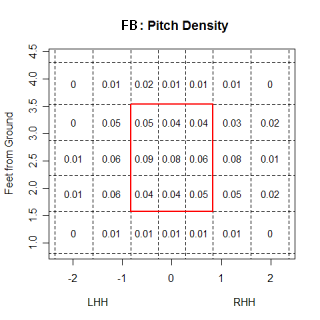
The next best thing to showing how different hitters fared against different types of pitches is showing how hitters did overall against Peavy.
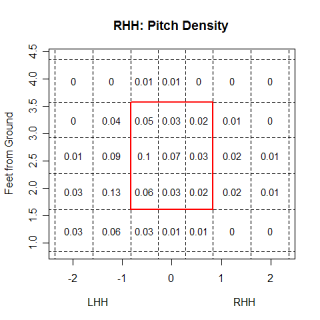

These charts show Peavy’s pattern of pitching to RHH and LHH. One quick thing you can see from the graph is that he works both groups of hitters outside more than inside, with the outer third of the strikezone and right off the plate being his primary targets. There seems to be a little bit evidence that Peavy pitches low in the strikezone, but he still throws a lot of pitches in the middle of the strikezone.
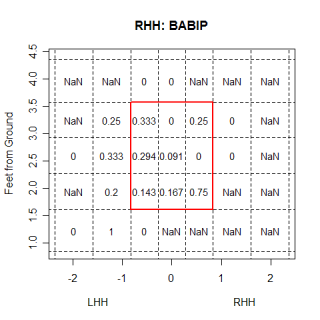
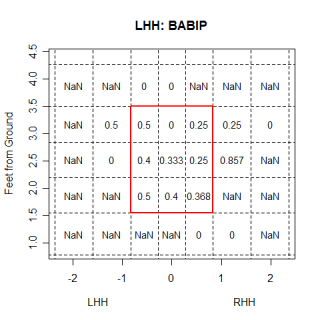
These BABIP graphs for LHH and RHH are probably not very accurate because of the small amount of ball-in-play data, but with a larger sample, they could be valuable for showing hot/cold zones.
Overall
Peavy’s fastball and slider are his two best pitches and he throws them the majority of the time. His slider has a couple different types of movement and could actually be two different pitches, although it looks more like the differences are variations of the same pitch. He also has a changeup and curveball that he throws much less frequently, and which aren’t as good. In pressure situations, it appears that he relies a little more on his fastball than normal, even though his slider creates more swings and misses. In the first inning he throws more fastballs than an average RHP, and throws a lot more fastballs than sliders, relative to how he pitches the rest of the game. He doesn't let the other team see all his pitches in the first inning and introduces his slider in the second inning, his changeup in the third inning and cuvrevball in the fifth inning.
*****************************************************************
I used Josh Kalk's player cards as a second opinion when analyzing pitches for Peavy and as I tried to improve my pitch clustering algorithm. If you've got an afternoon to kill, take a look through them...they're awesome. Josh has done some great work on standardizing the PITCH f/x data from different stadiums and different release points, so his data set is much bigger than mine right now (I'm only at the stage where I can look at pitches from 50 feet), and includes data for the entire season.
Comments
Outstanding work, as usual. A couple of observations: Peavy seems to get more called third strikes on the slider, more swinging third strikes on the fastball. Have you looked at the ratio for third strikes?
After a trip to Houston in July and watching Roy Oswalt, Peavy started mixing in breaking balls and change ups earlier in the game (my crude analysis here). Can you compare his August and September pitch selection to what he was doing earlier in the year?
Posted by: anthony at September 28, 2007 9:50 AM
What about pitch by count? And I have no idea if this is possible, but what about pitch tendencies by LI?
Posted by: dan at September 28, 2007 10:52 AM
Nice find with Kalk's player cards, hadn't seen that. Where do you get the info on the average movement, velo, etc. for a RHP or LHP's particular pitch?
Posted by: Kiley at September 28, 2007 12:33 PM
One thought on the increases in SL and CH as the innings go by - maybe this happens because he's facing some of the same batters for the second time? The correlation won't be perfect, of course, since he might see the top of the order again in the 2nd, 3rd, or 4th inning.
Posted by: Scott at September 28, 2007 2:05 PM
Anthony,
Nice call...for the 29 3rd strikes that Peavy got with his fastball, 25 (86%) were swinging, while only 4 (14%) were called. For the 54 3rd strikes he got with his slider, 40 (74%) were swinging and 14 (26%) were called.
Your other question takes a little longer for me to run right now, but I'll take a look this weekend. Your graphs make it seem that he might have changed his plan, although from the start vs. the Red Sox, it looks like he didn't introduce his other pitches at all.
Dan,
I did some looking at pitches by count and if I remember correctly, I don't think Peavy went to his slider more with 2 strikes, although I can look again when I write the full preview. I have written an article that dealt with pitch selection by LI (and Peavy),
http://baseballanalysts.com/archives/2007/07/under_pressure.php
and found that he went to the slider more in high leverage than low leverage. I pulled that data by hand and my database isn't quite set up to include the LI when every pitch is thrown, but I'd like to revisit the idea later.
Kiley
http://gd2.mlb.com/components/game/mlb/year_2007/month_09/day_26/gid_2007_09_26_arimlb_pitmlb_1/inning/
Thats the inning source data for the 9/26 game between the Dbacks and Pirates. The rest of the data is relatively easy to get to from there (change the dates in the address bar of your browser), and Alan Nathan's physics of baseball site has some good information to help get you started.
Scott,
I think thats exactly whats happening. I probably should have come out and said it, but thats exactly what I think is going on. He doesn't want to show the hitters all his pitches the first time they face him. If you watch the video, or look at the Gameday log of his start vs. the Giants from earlier this week, you can tell he is throwing a lot of fastballs. I went back and counted and he threw 5 pitches that were less than 90 MPH (4 were to Bonds) out of the 23 pitches he threw in that inning.
Posted by: joe p at September 28, 2007 4:31 PM
My bad, I think I phrased my question incorrectly. I'm looking for the source for the data of the MLB pitch averages that you reference for average slider usage, fastball velocity, movement, etc. I assume these league averages are either from an aggregating site, your algorithim, or MLBAM, I just couldn't find a suggestion of which source in the article. Thanks.
Posted by: Kiley at September 29, 2007 10:03 PM